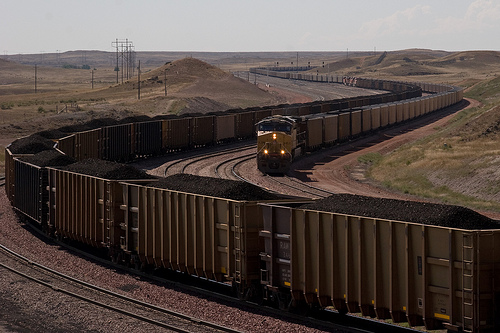Cloud Peak Energy, one of the major coal producers in the Powder River Basin, is doing its very best to sound upbeat about coal exports. In an investor conference call this past July, the company declared that, even though falling international coal prices had eaten into their earnings, their exports were “still profitable overall.”
But a close look at Cloud Peak’s second quarter financial statements suggests a far stranger story: the company’s export division actually made most of its profits from derivatives trading rather than coal. Stripping away the financial-speak, the implications are striking: Cloud Peak’s export arm made at least 10 times more money betting against coal than it did selling coal.
For those who are interested, here are the details…
If you read through Cloud Peak’s announcement of its results for the second quarter of 2013, you’ll see that the company divides its business into two segments: “Owned and Operated Mines” and “Logistics and Related Activities.” The logistics segment is basically Cloud Peak’s export arm: it arranges sales of Cloud Peak’s coal to end customers, with more than 85 percent of the division’s sales going to Asia. In the table breaking out the Logistics segment’s performance, Cloud Peak lists $2.8 million in “Adjusted EBITDA”—essentially a fancy term to describe the segment’s earnings, before subtracting out various expenses that cut across the company’s entire operation.
But the text below gives some clarity about where those $2.8 million in earnings came from.
[R]evenue decreased as a result of lower prices on our Asian deliveries related to low Newcastle benchmark prices. Our hedging program mitigated some of this impact, with a realized gain of $2.6 million in the quarter. [Emphasis added.]
What is this “hedging program”? Like most coal companies, Cloud Peak protects itself against falling coal prices by buying complex financial instruments that go up in value whenever coal prices go down. And as international coal prices fell over the second quarter, Cloud Peak netted about $2.6 million in cash from these “hedges.”
So that makes $2.8 million in earnings for the segment, of which $2.6 million came from price hedging—leaving a meager $200,000 in earnings from actual coal sales, or just 14 cents per ton of coal that the division sold. (Imagine going to the trouble of digging a ton of coal out of the ground in Wyoming, shipping it over 1,400 miles by rail, loading it onto a massive vessel, in which it will sail 4,600 miles across the Pacific to be burned in a Korean power plant…all to earn just 14 cents.)
There are two reasons why this is a Really Big Deal.
First, Cloud Peak is in a better position than any other Powder River Basin coal company to make money on coal exports. The coal from its Spring Creek mine has a higher energy content than most of its competitors’ coals, earning it a premium in the export market. Coal from Spring Creek also has a shorter (and therefore cheaper) rail trip to the west coast than most competing coals. By my estimate, Spring Creek coal can earn a profit at a price when most other coals are losing money.
So the fact that Cloud Peak’s export arm was barely breaking even signals that other PRB miners could actually be losing money on their coal exports. (And yes, coal companies might still export coal even if they’re losing money. “Take or pay” contracts with coal terminals require coal companies to pay fees even if they don’t export anything, so some coal companies could find that even if they’re losing money exporting coal, they’ll lose even more if they don’t export.)
Second, Cloud Peak’s scanty export earnings last quarter may foretell actual losses in this quarter. Benchmark Australian coal prices have fallen more than $5 per metric ton since June. And while some of Cloud Peak’s export sales may be locked in at high contract prices from earlier in the year, it’s quite likely that their third quarter export revenues will take yet another hit from falling coal prices.
Since last quarter’s margins were already razor thin, there’s a pretty good chance that Cloud Peak’s export division will soon be reporting its net earnings in red ink. And if that happens, it should set off warning bells for every Wall Street investor considering putting money into coal export terminals on the West Coast.
So stay tuned for those third-quarter results. Sure, Cloud Peak can try any number of tricks in its financial reports to keep export losses under wraps. Still, we may find an even more powerful bombshell hidden in next quarter’s numbers.
Hat tip to Michael Riordan for the links to Cloud Peak’s financials, and to Chris Troth and Erik Jansen for help with interpretation.


Comments are closed.